DSM-5: Diagnostic Assessment, Treatment, and Community Challenges
VerifiedAdded on 2022/07/28
|11
|2150
|20
Report
AI Summary
This report provides a comprehensive overview of the Diagnostic and Statistical Manual of Mental Disorders (DSM-5). It begins with an introduction to the DSM, its organization, and its role in classifying psychological disorders. The report details the structure of the DSM, including the various axes us...
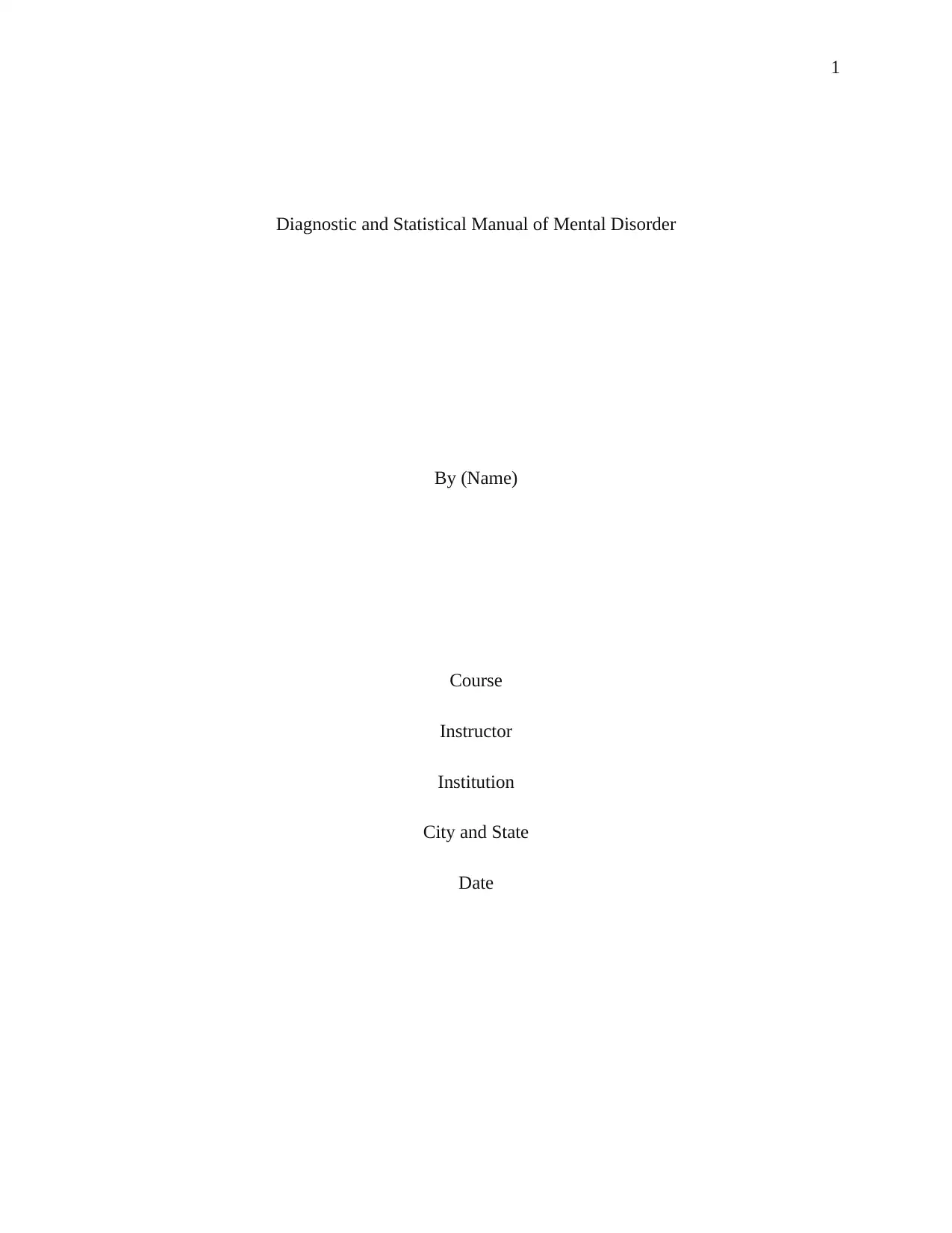
1
Diagnostic and Statistical Manual of Mental Disorder
By (Name)
Course
Instructor
Institution
City and State
Date
Diagnostic and Statistical Manual of Mental Disorder
By (Name)
Course
Instructor
Institution
City and State
Date
Paraphrase This Document
Need a fresh take? Get an instant paraphrase of this document with our AI Paraphraser
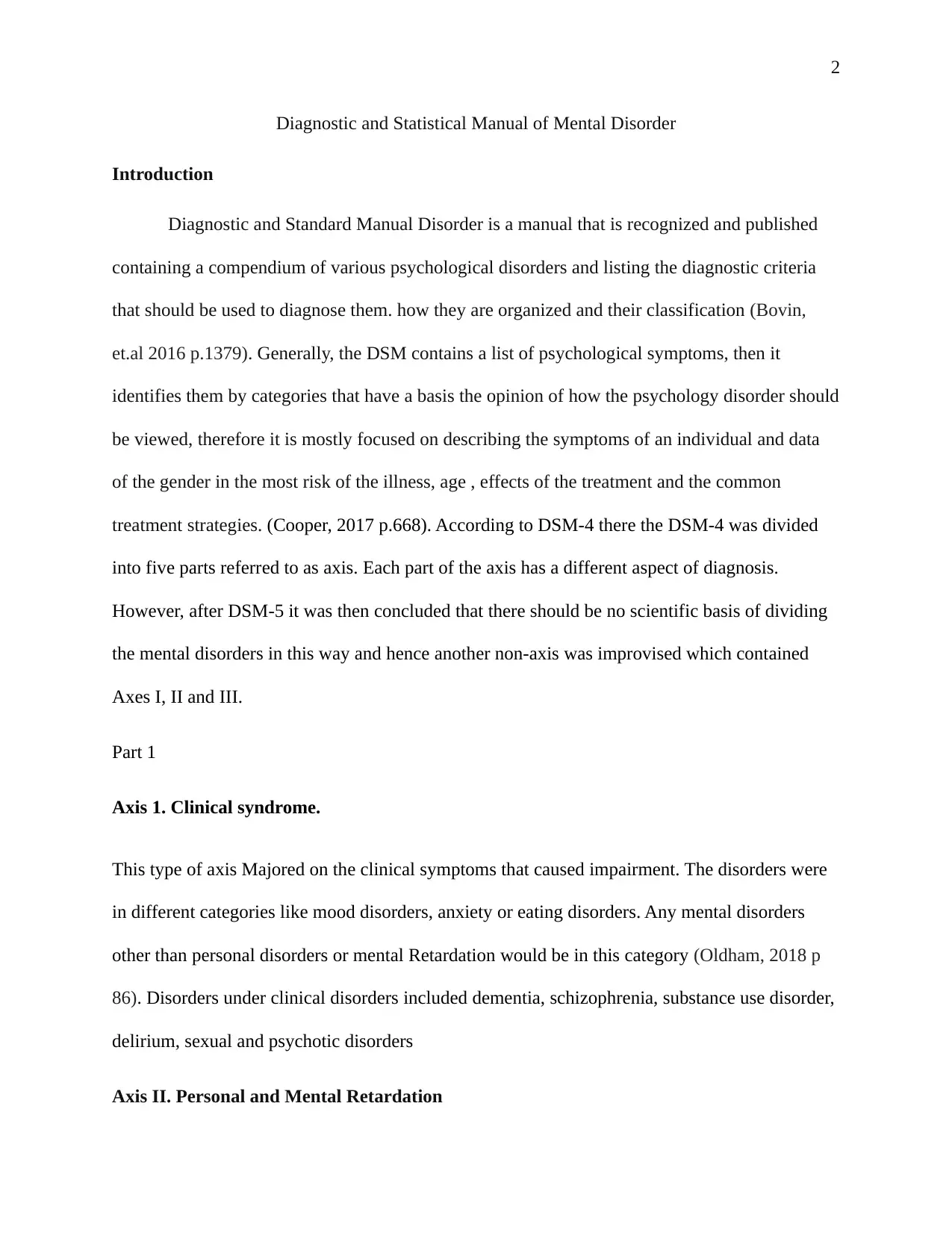
2
Diagnostic and Statistical Manual of Mental Disorder
Introduction
Diagnostic and Standard Manual Disorder is a manual that is recognized and published
containing a compendium of various psychological disorders and listing the diagnostic criteria
that should be used to diagnose them. how they are organized and their classification (Bovin,
et.al 2016 p.1379). Generally, the DSM contains a list of psychological symptoms, then it
identifies them by categories that have a basis the opinion of how the psychology disorder should
be viewed, therefore it is mostly focused on describing the symptoms of an individual and data
of the gender in the most risk of the illness, age , effects of the treatment and the common
treatment strategies. (Cooper, 2017 p.668). According to DSM-4 there the DSM-4 was divided
into five parts referred to as axis. Each part of the axis has a different aspect of diagnosis.
However, after DSM-5 it was then concluded that there should be no scientific basis of dividing
the mental disorders in this way and hence another non-axis was improvised which contained
Axes I, II and III.
Part 1
Axis 1. Clinical syndrome.
This type of axis Majored on the clinical symptoms that caused impairment. The disorders were
in different categories like mood disorders, anxiety or eating disorders. Any mental disorders
other than personal disorders or mental Retardation would be in this category (Oldham, 2018 p
86). Disorders under clinical disorders included dementia, schizophrenia, substance use disorder,
delirium, sexual and psychotic disorders
Axis II. Personal and Mental Retardation
Diagnostic and Statistical Manual of Mental Disorder
Introduction
Diagnostic and Standard Manual Disorder is a manual that is recognized and published
containing a compendium of various psychological disorders and listing the diagnostic criteria
that should be used to diagnose them. how they are organized and their classification (Bovin,
et.al 2016 p.1379). Generally, the DSM contains a list of psychological symptoms, then it
identifies them by categories that have a basis the opinion of how the psychology disorder should
be viewed, therefore it is mostly focused on describing the symptoms of an individual and data
of the gender in the most risk of the illness, age , effects of the treatment and the common
treatment strategies. (Cooper, 2017 p.668). According to DSM-4 there the DSM-4 was divided
into five parts referred to as axis. Each part of the axis has a different aspect of diagnosis.
However, after DSM-5 it was then concluded that there should be no scientific basis of dividing
the mental disorders in this way and hence another non-axis was improvised which contained
Axes I, II and III.
Part 1
Axis 1. Clinical syndrome.
This type of axis Majored on the clinical symptoms that caused impairment. The disorders were
in different categories like mood disorders, anxiety or eating disorders. Any mental disorders
other than personal disorders or mental Retardation would be in this category (Oldham, 2018 p
86). Disorders under clinical disorders included dementia, schizophrenia, substance use disorder,
delirium, sexual and psychotic disorders
Axis II. Personal and Mental Retardation

3
This type of axis discussed the long term problems that were not considered in the AXIS 1
Personal Disorders were the cause of various problems on how a patient would relate to the
world such as antisocial personality disorders, and historical personal disorders. On mental
retardation, it was characterized by the impairment and deficits in areas such as self-care and
personal skills (Schroeder, et.al 2018.)example of such conditions were Antisocial Personality
Disorder and Schizoid Personality Disorder
Axis III: Medical Conditions
These included physical and medical conditions that influence or worsen Axis 1 and Axis II
disorders. Some examples include HIV/AIDS and brain injuries. Axis III provided any medical
condition that was present that could affect patient mental disorder or management.
Axis IV Psychosocial and Environmental Problems
This section DSM discusses both the environmental and the social factors that affect Axis I and
Axis II. They related to unemployment, education, housing, economic.
Axis V Global Assessment of Functioning
This part was where the clinicians were able to rate the overall functioning of an individual based
on the assessment the health practitioners easily understood how the axis interacted and how they
affected the life of an individual.
Assessment
This type of axis discussed the long term problems that were not considered in the AXIS 1
Personal Disorders were the cause of various problems on how a patient would relate to the
world such as antisocial personality disorders, and historical personal disorders. On mental
retardation, it was characterized by the impairment and deficits in areas such as self-care and
personal skills (Schroeder, et.al 2018.)example of such conditions were Antisocial Personality
Disorder and Schizoid Personality Disorder
Axis III: Medical Conditions
These included physical and medical conditions that influence or worsen Axis 1 and Axis II
disorders. Some examples include HIV/AIDS and brain injuries. Axis III provided any medical
condition that was present that could affect patient mental disorder or management.
Axis IV Psychosocial and Environmental Problems
This section DSM discusses both the environmental and the social factors that affect Axis I and
Axis II. They related to unemployment, education, housing, economic.
Axis V Global Assessment of Functioning
This part was where the clinicians were able to rate the overall functioning of an individual based
on the assessment the health practitioners easily understood how the axis interacted and how they
affected the life of an individual.
Assessment
⊘ This is a preview!⊘
Do you want full access?
Subscribe today to unlock all pages.

Trusted by 1+ million students worldwide

4
A diagnostic assessment is very essential in determining a person able to be provided with
mental health service. The diagnostic reports give an evaluation of an individual’s mental health.
The Assessment Process
During the assessment, the health practitioner does just a brief of a health checkup, but in case an
individual shows symptoms of mental health problems, then the doctor has to do a complete
assessment or the patient is taken to a psychiatrist. The doctor may as well take the patient
through an interview (Zapf, et.al 2018 p.1). During the interview, the doctor questions the patient
on experienced symptoms, how the patient feels and the concerns. Then the doctor takes the
patient to a physical examination, where the patient is questioned on her health history if there is
a family history of mental illness. The objective of physical examination is to avoid physical
causes for a current mental health issue (Preskorn, 2016 p.308.). Thereon the doctor takes the
patient for a lab test either for a blood test or a urine test. Which is very important as there may
be suspected body complication which might be the cause such as anemia or B12 deficiency. For
a nervous system test computed tomography may be used. Finally, the practitioner may take the
patient through a written or a verbal test where the patient is expected to answer them out loud or
on a given piece of paper which are usually yes or no questions. These questions are relevant in
diagnosing the mental health of the patient as they are used to determine how well the patient can
reason, remember, (Loewentha, et.al 2018) the ability to take some routine tasks like dressing or
washing. Besides, the test will help the doctor detect some specific problems such as depression,
stress or anxiety.
A diagnostic assessment is very essential in determining a person able to be provided with
mental health service. The diagnostic reports give an evaluation of an individual’s mental health.
The Assessment Process
During the assessment, the health practitioner does just a brief of a health checkup, but in case an
individual shows symptoms of mental health problems, then the doctor has to do a complete
assessment or the patient is taken to a psychiatrist. The doctor may as well take the patient
through an interview (Zapf, et.al 2018 p.1). During the interview, the doctor questions the patient
on experienced symptoms, how the patient feels and the concerns. Then the doctor takes the
patient to a physical examination, where the patient is questioned on her health history if there is
a family history of mental illness. The objective of physical examination is to avoid physical
causes for a current mental health issue (Preskorn, 2016 p.308.). Thereon the doctor takes the
patient for a lab test either for a blood test or a urine test. Which is very important as there may
be suspected body complication which might be the cause such as anemia or B12 deficiency. For
a nervous system test computed tomography may be used. Finally, the practitioner may take the
patient through a written or a verbal test where the patient is expected to answer them out loud or
on a given piece of paper which are usually yes or no questions. These questions are relevant in
diagnosing the mental health of the patient as they are used to determine how well the patient can
reason, remember, (Loewentha, et.al 2018) the ability to take some routine tasks like dressing or
washing. Besides, the test will help the doctor detect some specific problems such as depression,
stress or anxiety.
Paraphrase This Document
Need a fresh take? Get an instant paraphrase of this document with our AI Paraphraser
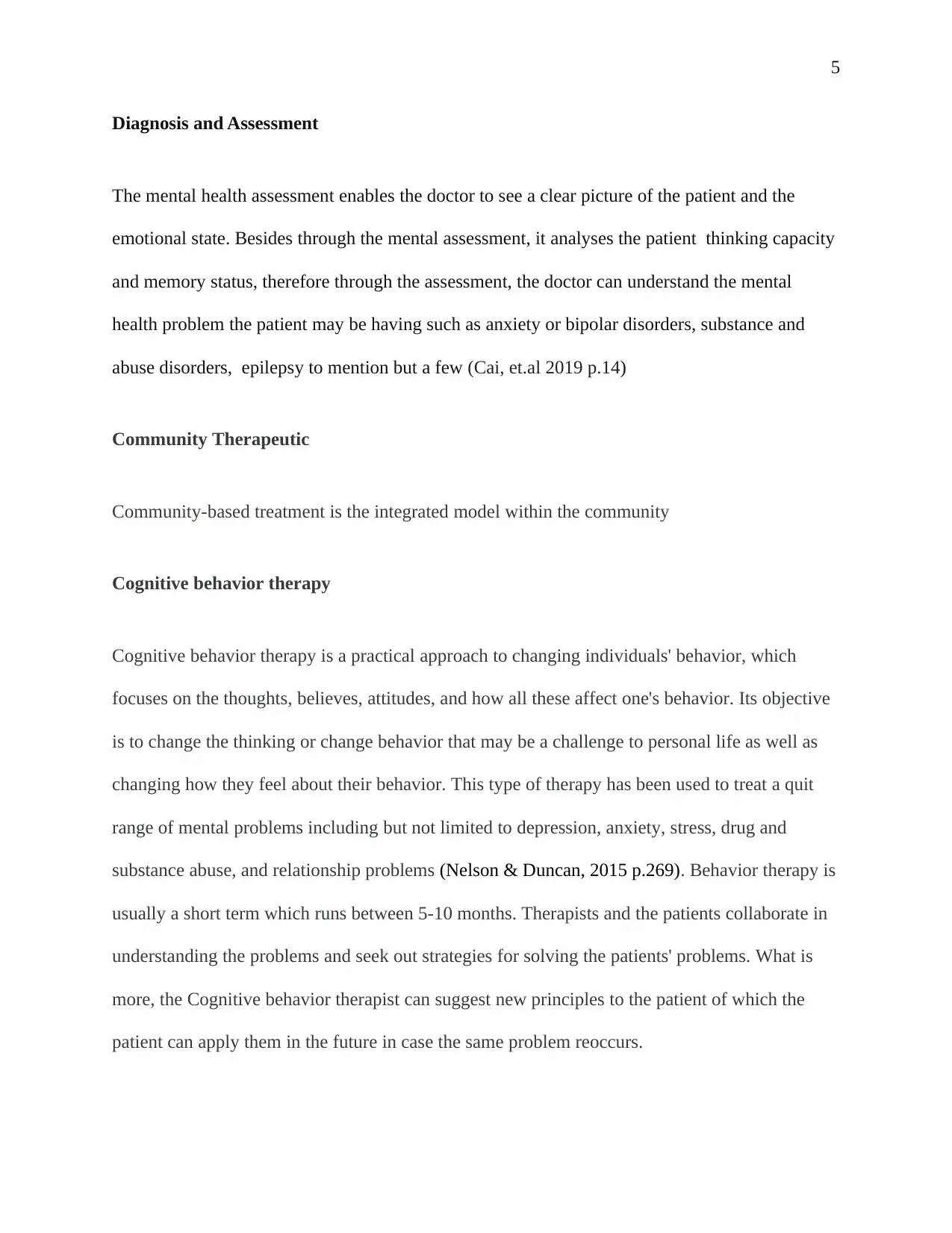
5
Diagnosis and Assessment
The mental health assessment enables the doctor to see a clear picture of the patient and the
emotional state. Besides through the mental assessment, it analyses the patient thinking capacity
and memory status, therefore through the assessment, the doctor can understand the mental
health problem the patient may be having such as anxiety or bipolar disorders, substance and
abuse disorders, epilepsy to mention but a few (Cai, et.al 2019 p.14)
Community Therapeutic
Community-based treatment is the integrated model within the community
Cognitive behavior therapy
Cognitive behavior therapy is a practical approach to changing individuals' behavior, which
focuses on the thoughts, believes, attitudes, and how all these affect one's behavior. Its objective
is to change the thinking or change behavior that may be a challenge to personal life as well as
changing how they feel about their behavior. This type of therapy has been used to treat a quit
range of mental problems including but not limited to depression, anxiety, stress, drug and
substance abuse, and relationship problems (Nelson & Duncan, 2015 p.269). Behavior therapy is
usually a short term which runs between 5-10 months. Therapists and the patients collaborate in
understanding the problems and seek out strategies for solving the patients' problems. What is
more, the Cognitive behavior therapist can suggest new principles to the patient of which the
patient can apply them in the future in case the same problem reoccurs.
Diagnosis and Assessment
The mental health assessment enables the doctor to see a clear picture of the patient and the
emotional state. Besides through the mental assessment, it analyses the patient thinking capacity
and memory status, therefore through the assessment, the doctor can understand the mental
health problem the patient may be having such as anxiety or bipolar disorders, substance and
abuse disorders, epilepsy to mention but a few (Cai, et.al 2019 p.14)
Community Therapeutic
Community-based treatment is the integrated model within the community
Cognitive behavior therapy
Cognitive behavior therapy is a practical approach to changing individuals' behavior, which
focuses on the thoughts, believes, attitudes, and how all these affect one's behavior. Its objective
is to change the thinking or change behavior that may be a challenge to personal life as well as
changing how they feel about their behavior. This type of therapy has been used to treat a quit
range of mental problems including but not limited to depression, anxiety, stress, drug and
substance abuse, and relationship problems (Nelson & Duncan, 2015 p.269). Behavior therapy is
usually a short term which runs between 5-10 months. Therapists and the patients collaborate in
understanding the problems and seek out strategies for solving the patients' problems. What is
more, the Cognitive behavior therapist can suggest new principles to the patient of which the
patient can apply them in the future in case the same problem reoccurs.
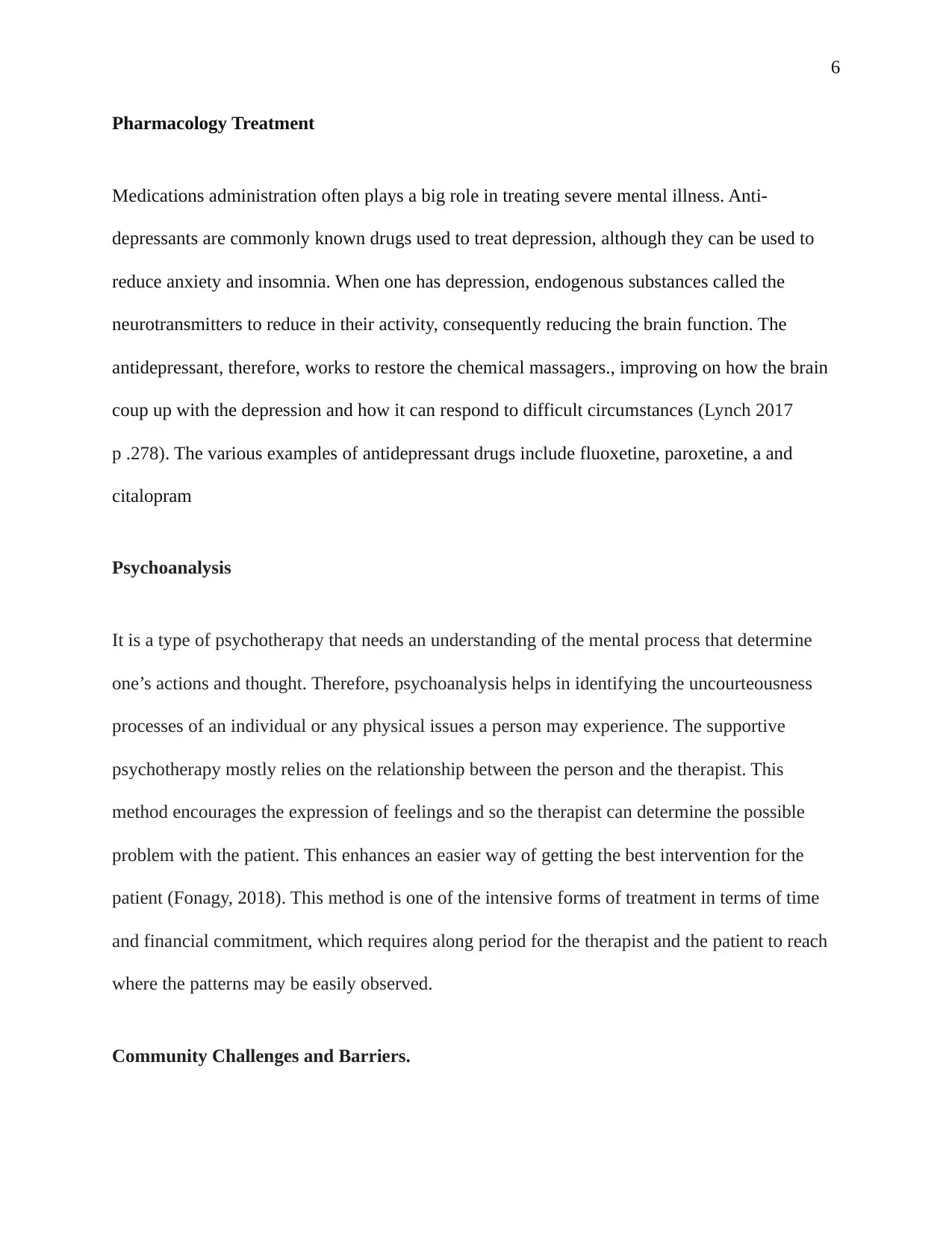
6
Pharmacology Treatment
Medications administration often plays a big role in treating severe mental illness. Anti-
depressants are commonly known drugs used to treat depression, although they can be used to
reduce anxiety and insomnia. When one has depression, endogenous substances called the
neurotransmitters to reduce in their activity, consequently reducing the brain function. The
antidepressant, therefore, works to restore the chemical massagers., improving on how the brain
coup up with the depression and how it can respond to difficult circumstances (Lynch 2017
p .278). The various examples of antidepressant drugs include fluoxetine, paroxetine, a and
citalopram
Psychoanalysis
It is a type of psychotherapy that needs an understanding of the mental process that determine
one’s actions and thought. Therefore, psychoanalysis helps in identifying the uncourteousness
processes of an individual or any physical issues a person may experience. The supportive
psychotherapy mostly relies on the relationship between the person and the therapist. This
method encourages the expression of feelings and so the therapist can determine the possible
problem with the patient. This enhances an easier way of getting the best intervention for the
patient (Fonagy, 2018). This method is one of the intensive forms of treatment in terms of time
and financial commitment, which requires along period for the therapist and the patient to reach
where the patterns may be easily observed.
Community Challenges and Barriers.
Pharmacology Treatment
Medications administration often plays a big role in treating severe mental illness. Anti-
depressants are commonly known drugs used to treat depression, although they can be used to
reduce anxiety and insomnia. When one has depression, endogenous substances called the
neurotransmitters to reduce in their activity, consequently reducing the brain function. The
antidepressant, therefore, works to restore the chemical massagers., improving on how the brain
coup up with the depression and how it can respond to difficult circumstances (Lynch 2017
p .278). The various examples of antidepressant drugs include fluoxetine, paroxetine, a and
citalopram
Psychoanalysis
It is a type of psychotherapy that needs an understanding of the mental process that determine
one’s actions and thought. Therefore, psychoanalysis helps in identifying the uncourteousness
processes of an individual or any physical issues a person may experience. The supportive
psychotherapy mostly relies on the relationship between the person and the therapist. This
method encourages the expression of feelings and so the therapist can determine the possible
problem with the patient. This enhances an easier way of getting the best intervention for the
patient (Fonagy, 2018). This method is one of the intensive forms of treatment in terms of time
and financial commitment, which requires along period for the therapist and the patient to reach
where the patterns may be easily observed.
Community Challenges and Barriers.
⊘ This is a preview!⊘
Do you want full access?
Subscribe today to unlock all pages.

Trusted by 1+ million students worldwide
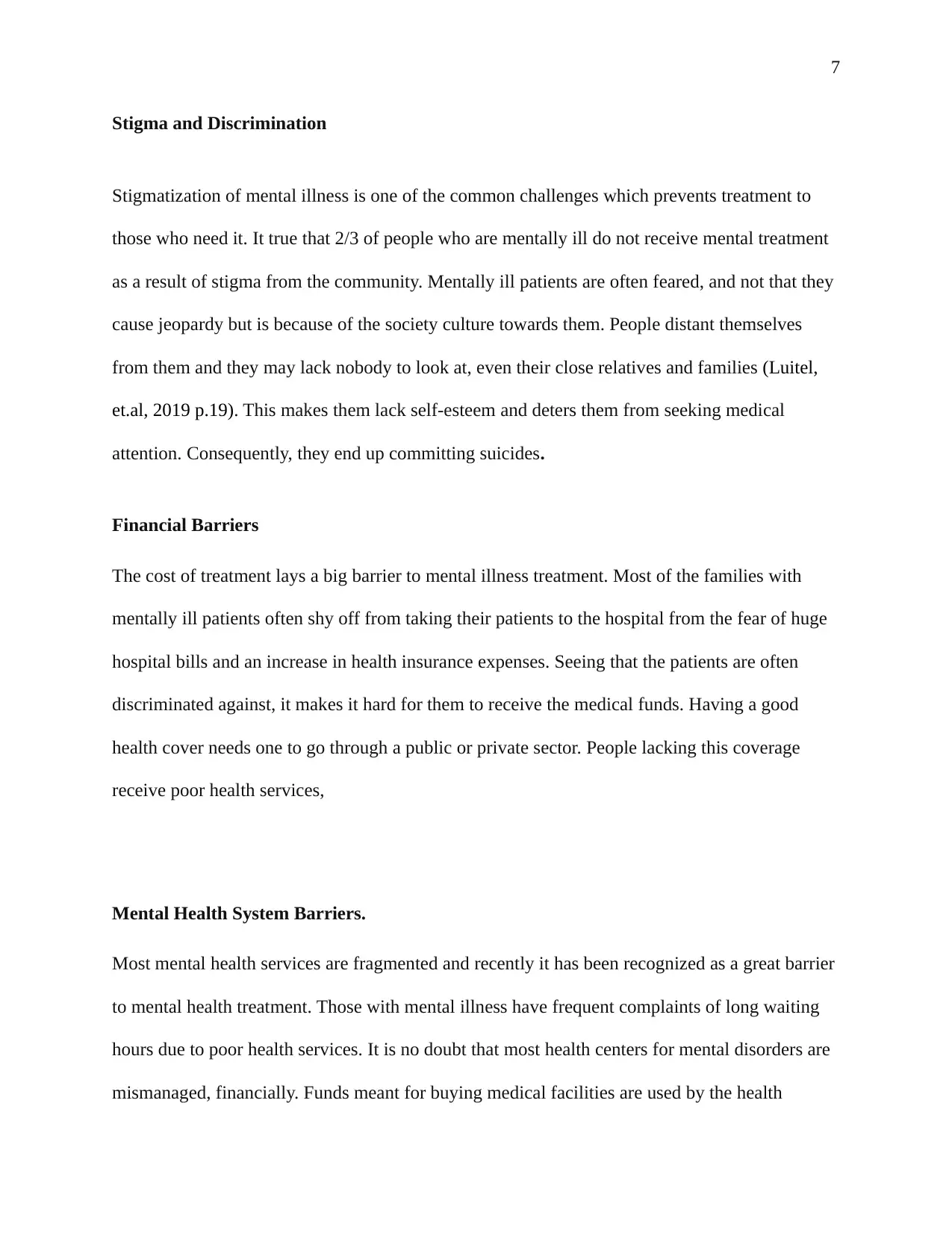
7
Stigma and Discrimination
Stigmatization of mental illness is one of the common challenges which prevents treatment to
those who need it. It true that 2/3 of people who are mentally ill do not receive mental treatment
as a result of stigma from the community. Mentally ill patients are often feared, and not that they
cause jeopardy but is because of the society culture towards them. People distant themselves
from them and they may lack nobody to look at, even their close relatives and families (Luitel,
et.al, 2019 p.19). This makes them lack self-esteem and deters them from seeking medical
attention. Consequently, they end up committing suicides.
Financial Barriers
The cost of treatment lays a big barrier to mental illness treatment. Most of the families with
mentally ill patients often shy off from taking their patients to the hospital from the fear of huge
hospital bills and an increase in health insurance expenses. Seeing that the patients are often
discriminated against, it makes it hard for them to receive the medical funds. Having a good
health cover needs one to go through a public or private sector. People lacking this coverage
receive poor health services,
Mental Health System Barriers.
Most mental health services are fragmented and recently it has been recognized as a great barrier
to mental health treatment. Those with mental illness have frequent complaints of long waiting
hours due to poor health services. It is no doubt that most health centers for mental disorders are
mismanaged, financially. Funds meant for buying medical facilities are used by the health
Stigma and Discrimination
Stigmatization of mental illness is one of the common challenges which prevents treatment to
those who need it. It true that 2/3 of people who are mentally ill do not receive mental treatment
as a result of stigma from the community. Mentally ill patients are often feared, and not that they
cause jeopardy but is because of the society culture towards them. People distant themselves
from them and they may lack nobody to look at, even their close relatives and families (Luitel,
et.al, 2019 p.19). This makes them lack self-esteem and deters them from seeking medical
attention. Consequently, they end up committing suicides.
Financial Barriers
The cost of treatment lays a big barrier to mental illness treatment. Most of the families with
mentally ill patients often shy off from taking their patients to the hospital from the fear of huge
hospital bills and an increase in health insurance expenses. Seeing that the patients are often
discriminated against, it makes it hard for them to receive the medical funds. Having a good
health cover needs one to go through a public or private sector. People lacking this coverage
receive poor health services,
Mental Health System Barriers.
Most mental health services are fragmented and recently it has been recognized as a great barrier
to mental health treatment. Those with mental illness have frequent complaints of long waiting
hours due to poor health services. It is no doubt that most health centers for mental disorders are
mismanaged, financially. Funds meant for buying medical facilities are used by the health
Paraphrase This Document
Need a fresh take? Get an instant paraphrase of this document with our AI Paraphraser

8
coordinators. Rehabilitation centers for the sick mentally challenged are no more and the ones
running are poorly managed (Gates, &Copeland, 2017 p1025). This has always increased
suffering regardless of raising alarms to the government and the health leaders concerned.
coordinators. Rehabilitation centers for the sick mentally challenged are no more and the ones
running are poorly managed (Gates, &Copeland, 2017 p1025). This has always increased
suffering regardless of raising alarms to the government and the health leaders concerned.
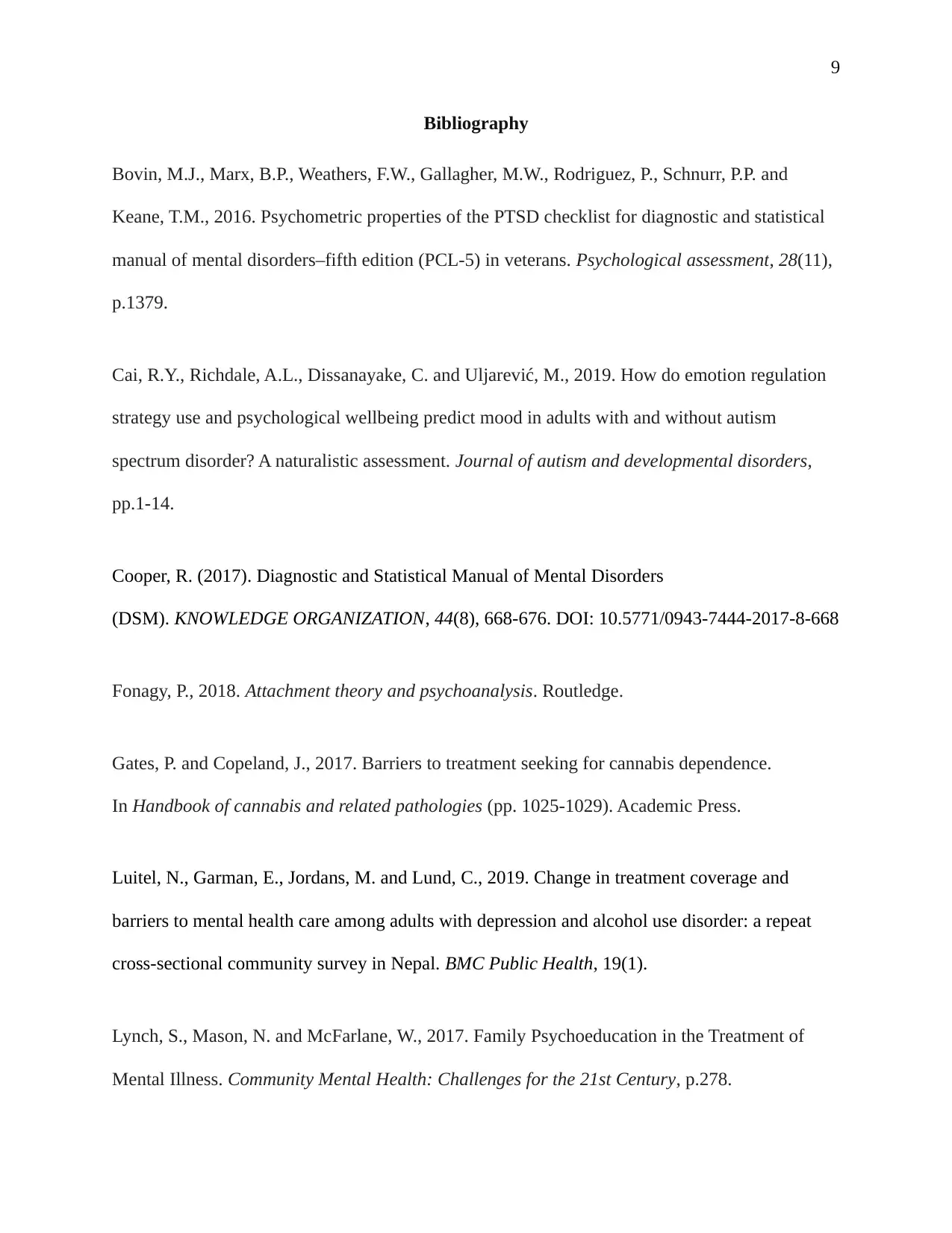
9
Bibliography
Bovin, M.J., Marx, B.P., Weathers, F.W., Gallagher, M.W., Rodriguez, P., Schnurr, P.P. and
Keane, T.M., 2016. Psychometric properties of the PTSD checklist for diagnostic and statistical
manual of mental disorders–fifth edition (PCL-5) in veterans. Psychological assessment, 28(11),
p.1379.
Cai, R.Y., Richdale, A.L., Dissanayake, C. and Uljarević, M., 2019. How do emotion regulation
strategy use and psychological wellbeing predict mood in adults with and without autism
spectrum disorder? A naturalistic assessment. Journal of autism and developmental disorders,
pp.1-14.
Cooper, R. (2017). Diagnostic and Statistical Manual of Mental Disorders
(DSM). KNOWLEDGE ORGANIZATION, 44(8), 668-676. DOI: 10.5771/0943-7444-2017-8-668
Fonagy, P., 2018. Attachment theory and psychoanalysis. Routledge.
Gates, P. and Copeland, J., 2017. Barriers to treatment seeking for cannabis dependence.
In Handbook of cannabis and related pathologies (pp. 1025-1029). Academic Press.
Luitel, N., Garman, E., Jordans, M. and Lund, C., 2019. Change in treatment coverage and
barriers to mental health care among adults with depression and alcohol use disorder: a repeat
cross-sectional community survey in Nepal. BMC Public Health, 19(1).
Lynch, S., Mason, N. and McFarlane, W., 2017. Family Psychoeducation in the Treatment of
Mental Illness. Community Mental Health: Challenges for the 21st Century, p.278.
Bibliography
Bovin, M.J., Marx, B.P., Weathers, F.W., Gallagher, M.W., Rodriguez, P., Schnurr, P.P. and
Keane, T.M., 2016. Psychometric properties of the PTSD checklist for diagnostic and statistical
manual of mental disorders–fifth edition (PCL-5) in veterans. Psychological assessment, 28(11),
p.1379.
Cai, R.Y., Richdale, A.L., Dissanayake, C. and Uljarević, M., 2019. How do emotion regulation
strategy use and psychological wellbeing predict mood in adults with and without autism
spectrum disorder? A naturalistic assessment. Journal of autism and developmental disorders,
pp.1-14.
Cooper, R. (2017). Diagnostic and Statistical Manual of Mental Disorders
(DSM). KNOWLEDGE ORGANIZATION, 44(8), 668-676. DOI: 10.5771/0943-7444-2017-8-668
Fonagy, P., 2018. Attachment theory and psychoanalysis. Routledge.
Gates, P. and Copeland, J., 2017. Barriers to treatment seeking for cannabis dependence.
In Handbook of cannabis and related pathologies (pp. 1025-1029). Academic Press.
Luitel, N., Garman, E., Jordans, M. and Lund, C., 2019. Change in treatment coverage and
barriers to mental health care among adults with depression and alcohol use disorder: a repeat
cross-sectional community survey in Nepal. BMC Public Health, 19(1).
Lynch, S., Mason, N. and McFarlane, W., 2017. Family Psychoeducation in the Treatment of
Mental Illness. Community Mental Health: Challenges for the 21st Century, p.278.
⊘ This is a preview!⊘
Do you want full access?
Subscribe today to unlock all pages.

Trusted by 1+ million students worldwide
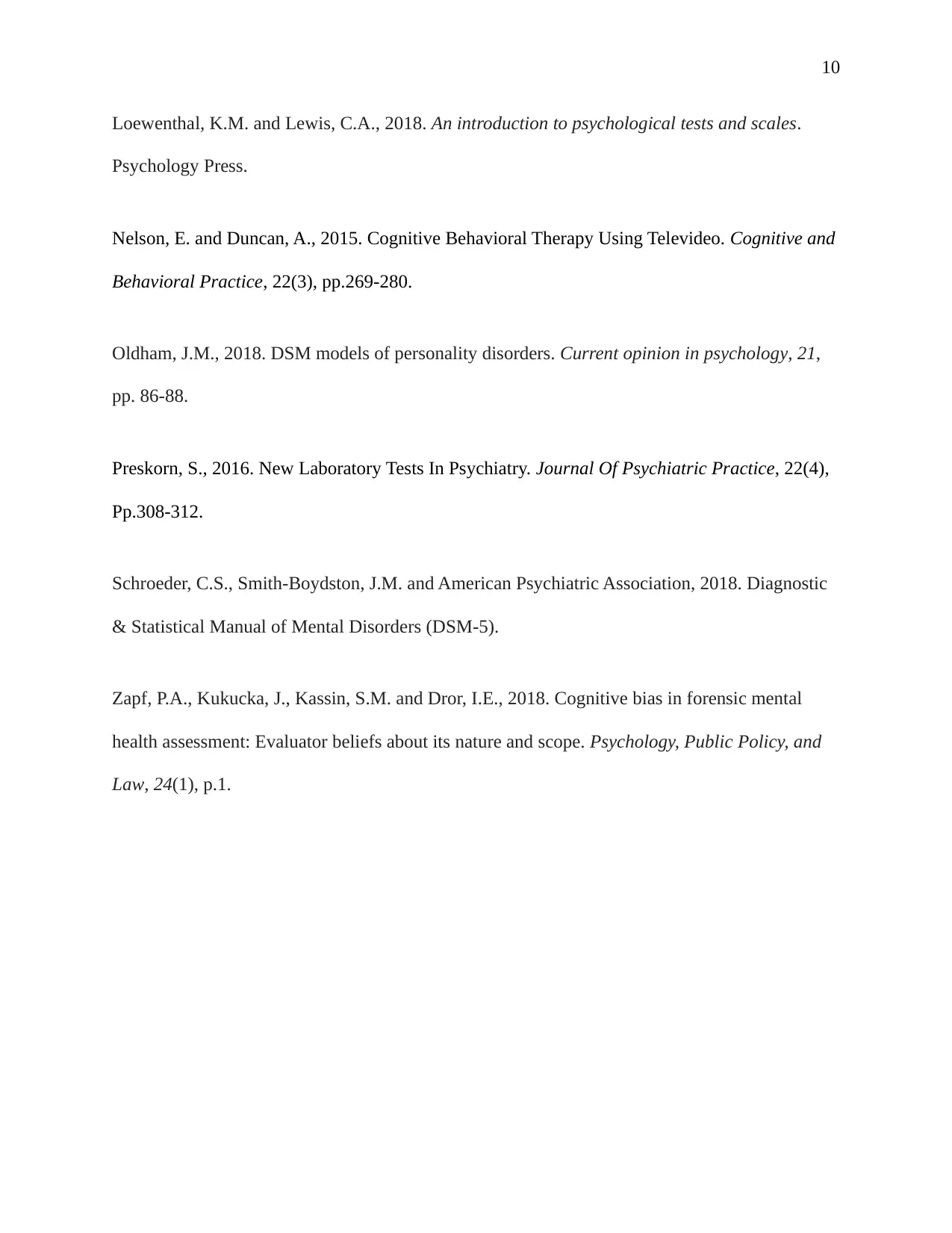
10
Loewenthal, K.M. and Lewis, C.A., 2018. An introduction to psychological tests and scales.
Psychology Press.
Nelson, E. and Duncan, A., 2015. Cognitive Behavioral Therapy Using Televideo. Cognitive and
Behavioral Practice, 22(3), pp.269-280.
Oldham, J.M., 2018. DSM models of personality disorders. Current opinion in psychology, 21,
pp. 86-88.
Preskorn, S., 2016. New Laboratory Tests In Psychiatry. Journal Of Psychiatric Practice, 22(4),
Pp.308-312.
Schroeder, C.S., Smith-Boydston, J.M. and American Psychiatric Association, 2018. Diagnostic
& Statistical Manual of Mental Disorders (DSM-5).
Zapf, P.A., Kukucka, J., Kassin, S.M. and Dror, I.E., 2018. Cognitive bias in forensic mental
health assessment: Evaluator beliefs about its nature and scope. Psychology, Public Policy, and
Law, 24(1), p.1.
Loewenthal, K.M. and Lewis, C.A., 2018. An introduction to psychological tests and scales.
Psychology Press.
Nelson, E. and Duncan, A., 2015. Cognitive Behavioral Therapy Using Televideo. Cognitive and
Behavioral Practice, 22(3), pp.269-280.
Oldham, J.M., 2018. DSM models of personality disorders. Current opinion in psychology, 21,
pp. 86-88.
Preskorn, S., 2016. New Laboratory Tests In Psychiatry. Journal Of Psychiatric Practice, 22(4),
Pp.308-312.
Schroeder, C.S., Smith-Boydston, J.M. and American Psychiatric Association, 2018. Diagnostic
& Statistical Manual of Mental Disorders (DSM-5).
Zapf, P.A., Kukucka, J., Kassin, S.M. and Dror, I.E., 2018. Cognitive bias in forensic mental
health assessment: Evaluator beliefs about its nature and scope. Psychology, Public Policy, and
Law, 24(1), p.1.
Paraphrase This Document
Need a fresh take? Get an instant paraphrase of this document with our AI Paraphraser

11
1 out of 11
Related Documents
Your All-in-One AI-Powered Toolkit for Academic Success.
+13062052269
info@desklib.com
Available 24*7 on WhatsApp / Email
![[object Object]](/_next/static/media/star-bottom.7253800d.svg)
Unlock your academic potential
© 2024 | Zucol Services PVT LTD | All rights reserved.





